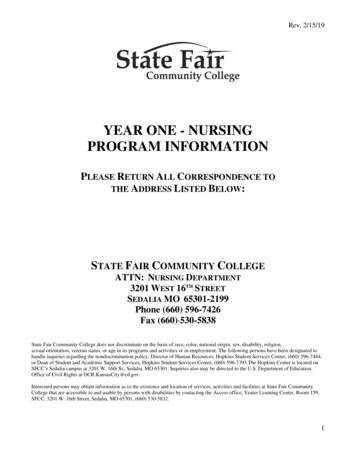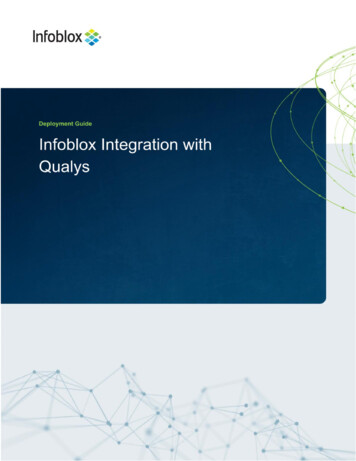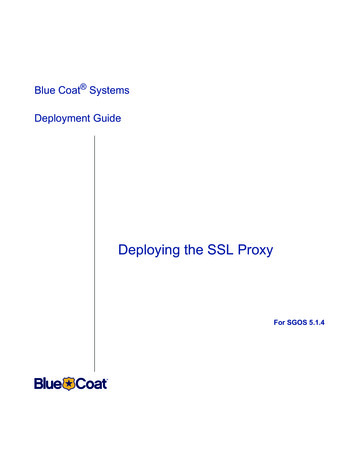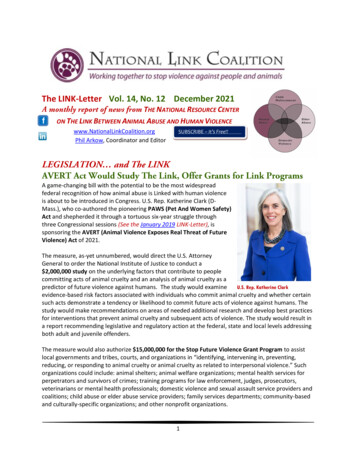
Transcription
NOMINATION OF HISTORIC BUILDING, STRUCTURE, SITE, OR OBJECTPHILADELPHIA REGISTER OF HISTORIC PLACESPHILADELPHIA HISTORICAL COMMISSIONSUBMIT ALL ATTACHED MATERIALS ON PAPER AND IN ELECTRONIC FORM ON CD (MS WORD FORMAT)1. ADDRESS OF HISTORIC RESOURCE (must comply with an Office of Property Assessment address)Street address: 1101-03 Frankford AvenuePostal code: 19125Councilmanic District: 52. NAME OF HISTORIC RESOURCEHistoric Name: Mantin Landenberger Mill/Morse Elevator Works/Otis Elevator WorksCommon Name: 1101-1103 Frankford Avenue3. TYPE OF HISTORIC RESOURCEBuildingStructureSiteObjectpoor4. PROPERTY cupiedvacantunder constructionruinsunknownCurrent use: Conversion5. BOUNDARY DESCRIPTIONPlease attach a plot plan and written description of the boundary.6. DESCRIPTIONPlease attach a description of the historic resource and supplement with current photographs.7. SIGNIFICANCEPlease attach the Statement of Significance.Period of Significance (from year to year): from 1851 to 1946Date(s) of construction and/or alteration: Constructed 1851 and 1856Architect, engineer, and/or designer: UnknownBuilder, contractor, and/or artisan: UnknownOriginal owner: Martin LandenbergerOther significant persons: Stephen Ambrose Morse
CRITERIA FOR DESIGNATION:The historic resource satisfies the following criteria for designation (check all that apply):(a) Has significant character, interest or value as part of the development, heritage or culturalcharacteristics of the City, Commonwealth or Nation or is associated with the life of a personsignificant in the past; or,(b) Is associated with an event of importance to the history of the City, Commonwealth or Nation;or,(c) Reflects the environment in an era characterized by a distinctive architectural style; or,(d) Embodies distinguishing characteristics of an architectural style or engineering specimen; or,(e) Is the work of a designer, architect, landscape architect or designer, or engineer whose workhas significantly influenced the historical, architectural, economic, social, or cultural development ofthe City, Commonwealth or Nation; or,(f) Contains elements of design, detail, materials or craftsmanship which represent a significantinnovation; or,(g) Is part of or related to a square, park or other distinctive area which should be preservedaccording to an historic, cultural or architectural motif; or,(h) Owing to its unique location or singular physical characteristic, represents an established andfamiliar visual feature of the neighborhood, community or City; or,(i) Has yielded, or may be likely to yield, information important in pre-history or history; or(j) Exemplifies the cultural, political, economic, social or historical heritage of the community.8. MAJOR BIBLIOGRAPHICAL REFERENCESPlease attach a bibliography.9. NOMINATORName with Title Oscar Beisert, Architectural Historian Email Oscar.beisert@gmail.comOrganization NA Date September 1, 2015Street Address 205 Rochelle Avenue Telephone 717.602.5002City, State, and Postal Code Philadelphia, Pennsylvania 19128Nominatorisis notthe property owner.PHC USE ONLYDate of ate of Notice Issuance:Property Owner at Time of NoticeName:Address:City:State:Postal Code:Date(s) Reviewed by the Committee on Historic Designation:Date(s) Reviewed by the Historical Commission:Date of Final Action:DesignatedRejected4/11/13
6. BOUNDARY DESCRIPTION243516Boundary MapSegment 131’-7‖Segment 285’-6‖Segment 33’-8‖Segment 4Segment 578’-11‖35’-3‖Segment 6164’-5‖ALL THAT CERTAIN lot or piece of ground with the buildings and improvements thereonSITUATE in the 18th Ward of the City of Philadelphia, as follows, to wit:BEGINNING at a point at the intersection of the East side of Frankford Avenue (60 feet wide)and the North side of Wildey Street (50 feet wide); thence Northward along the East side ofFrankford Avenue 31 feet 7 inches to a point; thence extending Eastward along a line at rightangles to Frankford Avenue 85 feet 6 inches to a point; thence extending Northward along a lineparallel with Frankford Avenue 3 feet 8 inches to a point; thence extending Eastward along a lineat right angles to Frankford Avenue 78 feet 11 inches to a point; thence extending Southwardalong a line parallel with Frankford Avenue 35 feet 3 inches to a point on the North side ofWildey Street and thence extending Westward along the same 164 feet 5 inches to the point andplace of beginning.BEING NO.: 1101-1103 Frankford AvenueBRT/OPA ACCOUNT NO.: 884961830Nomination: Martin Landenberger’s Hosiery Mill/Morse Elevator Works/Otis Elevator Co.1101-03 Frankford Avenue1
1916 Sanborn Real Estate Atlas, Vol. 3Courtesy Pennsylvania State University Libraries2Nomination: Martin Landenberger’s Hosiery Mill/Morse Elevator Works/Otis Elevator Co.1101-03 Frankford Avenue
7. PHYSICAL DESCRIPTIONThe building at 1101–1103 Frankford Avenue is one of the primary industrial buildings of thecomplex that encompasses those located along the corners of Frankford Avenue, Wildey, Sarah,and Shackamaxon Streets. Built between 1851 and c.1920, the Morse Elevator Works, consistingof eight brick buildings located at 1101–1103, 1105, 1107–1109, 1111–1119 [1115], and 1121–1127 [1117] Frankford Avenue, 1045–1049 Sarah Street, 1100–1110 Shackamaxon Street, and121–131 Wildey Street, chronicles Philadelphia’s association with a series of elevatorNomination: Martin Landenberger’s Hosiery Mill/Morse Elevator Works/Otis Elevator Co.1101-03 Frankford Avenue3
manufacturers who participated in a nationwide marketplace. Most of the buildings in the Morsecomplex, including earlier Landenberger buildings, were erected between 1851 and 1902-03.The oldest structure in the complex, 1101–1103 Frankford Avenue stands at the northeast cornerof Frankford Avenue and Wildey Street and exhibits two periods of construction—the first halfin 1851 and the second half in 1856. From the corner, the building reads 1856 to 1851, as thesecond phase of the building is at the corner of Frankford Avenue and Wildey, while the firstphase is at the rear, appearing as an addition. The first phase was constructed four bays in widthalong Frankford Avenue and twenty bays along Wildey Street, the mill stands four stories tallwith basement. The easternmost ten bays along Wildey contain the earliest portion of the mill.Erected in 1851, this early section of the building features a low slung gable-roofed with acupola capping the eastern half of the otherwise flat, tin-sheathed roof. The fenestration employsItalianate stylistic arrangements, which is amplified by higher bays at the first first-story bays.The same Italianate stylistic forms are continue along Wildey Street. The second half of thebuilding was completed in 1856. It features an elaborate cast iron facade on the ground floor ofits Frankford Avenue elevation, and, like the earlier section, it stands four stories with abasement. The building is rough cast and painted white. The cast iron front has been painted witha cementitious green paint to give the appearance of stone. Three thin pilasters flanked by widerpilasters and topped by acanthus leaf and floral capitals support an entablature and cornice overthe first-story bays. Letters forming ―MARTIN LANDENBERGER‖ are still dimly visible in thefrieze of the entablature. The upper stories exhibit windows of varying height, leading theItalianate fenestration.Embedded in a second-story brick filled bay of the earlier portion of the building are the ends ofiron beams and an iron lintel. These pieces were part of an enclosed bridge that crossed aboveWildey Street and joined this building to the one at 1045–1055 Frankford Avenue on thesoutheast corner of Frankford Avenue and Wildey Street.Along the sidewalk at Frankford Avenue and Wildey Street are large portions of Belgian blockstone pavements, which appear to be period to the building’s historical significance and shouldbe included in this nomination.Appending 1101–03 Frankford Avenue to the northeast, four additional buildings front onFrankford Avenue, all built circa 1899, comprise the most intact portion of the former elevatorworks constructed by Morse, Williams & Co., serving as warehouses and machine shops.4Nomination: Martin Landenberger’s Hosiery Mill/Morse Elevator Works/Otis Elevator Co.1101-03 Frankford Avenue
Looking northeast at 1101–1103, 1105, 1107–1109, 1111–1115, 1117-1119 and 1121–1127 Frankford Avenue.Looking north.Nomination: Martin Landenberger’s Hosiery Mill/Morse Elevator Works/Otis Elevator Co.1101-03 Frankford Avenue5
Looking northwest.Looking east.6Nomination: Martin Landenberger’s Hosiery Mill/Morse Elevator Works/Otis Elevator Co.1101-03 Frankford Avenue
Looking west.Looking northeastNomination: Martin Landenberger’s Hosiery Mill/Morse Elevator Works/Otis Elevator Co.1101-03 Frankford Avenue7
Looking north.Looking east8Nomination: Martin Landenberger’s Hosiery Mill/Morse Elevator Works/Otis Elevator Co.1101-03 Frankford Avenue
Looking northwest.Looking southwest.Nomination: Martin Landenberger’s Hosiery Mill/Morse Elevator Works/Otis Elevator Co.1101-03 Frankford Avenue9
Looking northeast.10Nomination: Martin Landenberger’s Hosiery Mill/Morse Elevator Works/Otis Elevator Co.1101-03 Frankford Avenue
Looking south.Nomination: Martin Landenberger’s Hosiery Mill/Morse Elevator Works/Otis Elevator Co.1101-03 Frankford Avenue11
8. STATEMENT OF SIGNIFICANCEThe building at 1101–1103 Frankford Avenue is a primary component of a complex of buildingsthat represent an industrial site related to the following important enterprises: the MartinLandenberger Hosiery Mill Complex, dating from 1851 to 1920; the Morse Elevator Works ofMorse Williams & Co., operating on the site from 1886 to 1910; and the Otis Elevator Company,Philadelphia, of New York, New York, from 1910 to the 1940s. One within a larger complex,1101–1103 Frankford Avenue is a significant historic resource that merits designation by thePhiladelphia Historical Commission and inclusion on the Philadelphia Register of HistoricPlaces. The building satisfies Criteria for Designation a, h, and j of Section 14–1004 of thePhiladelphia Code. 1101–1103 Frankford Avenue:(a) Has significant character, interest or value as part of the development, heritage or culturalcharacteristics of the City, Commonwealth or Nation or is associated with the life of a personsignificant in the past;(c) Reflects the environment in an era characterized by a distinctive architectural style.(h) Owing to its unique location or singular physical characteristic, represents an established andfamiliar visual feature of the neighborhood, community or City; and(j) Exemplifies the cultural, political, economic, social or historical heritage of the community.Interior View of the Morse Elevator Works. Courtesy the Philadelphia Athenaeum12Nomination: Martin Landenberger’s Hosiery Mill/Morse Elevator Works/Otis Elevator Co.1101-03 Frankford Avenue
(a) Has significant character, interest or value as part of the development, heritage orcultural characteristics of the City, Commonwealth or Nation or is associated with the lifeof a person significant in the past;(j) Exemplifies the cultural, political, economic, social or historical heritage of thecommunity.According to the Society for Industrial Archaeology, the industrial buildings located along thecorners of Frankford Avenue, Wildey, Sarah, and Shackamaxon Streets form the, earliest, extantand coherent industrial complex in Fishtown, as well as the larger Kensington neighborhood. Asa principal component of that complex, 1101–1103 Frankford Avenue has significant character,interest or value as part of the development, heritage and cultural characteristics of the City ofPhiladelphia, representing an important and principal manufacturer of hosiery—the MartinLandenberger Hosiery Mill; an early and important elevator manufacturer—the Morse ElevatorWorks and the associated Morse, Williams & Co., once the leading producer of freight elevatorsin the world; Steven A. Morse, an eminent inventor and manufacturer; and the Philadelphiabranch of the most important elevator manufacturer in America—the Otis Elevator Company.The plain facts just stated relate to 1101–1103 Frankford Avenue, individually, and within thesaid complex of buildings, which document Fishtown’s, as well as Kensington’s, rich anddiverse industrial tradition. This documentation exemplifies the cultural, political, economic,social, and historic heritage of the community.Fishtown Section of Philadelphia1101–03 Frankford Avenue is located in Fishtown, which is part of the larger Kensingtonneighborhood of Philadelphia. The following section is provided courtesy the author Rich Remerand provides a comprehensive historic context on the Kensington neighborhood and the sectioncalled Fishtown.The old Shackamaxon Tract, surveyed early in the 17th Century, became duringits earliest period of European settlement, the home to members of the Cox,Rambo and Nelson families of New Sweden. They had been granted these landsnorth of the Cohocksink Creek and marshlands, in the vicinity of the Great Elmnear the Lenape settlement known as ―Kachamensi.‖ The Unami clan of theLenape considered these rich meadowlands their chief dwelling place and thetraditional site for tribal conferences and congresses. From a Europeanperspective at least, William Penn’s ―treaty‖ with the Lenape was the mostimportant conference that occurred there. It is immortalized in Benjamin West’sfamous painting.The British settlers of the new colony of Pennsylvania soon anglicized the tract’sname to ―Shackamaxon,‖ which also became the name of one of its earlieststreets. Penn’s assistant surveyor of the colony, Thomas Fairman, became themajor landowner in the area and in 1702 built himself a fine brick and stonemansion on the bank of the Delaware, under what came to be called the ―TreatyElm.‖ In 1729 Anthony Palmer, a wealthy provincial councilor moved intoFairman’s mansion when he purchased the grounds. By 1730, Palme named hisNomination: Martin Landenberger’s Hosiery Mill/Morse Elevator Works/Otis Elevator Co.1101-03 Frankford Avenue13
new estate ―Kensington.‖ Palmer’s Kensington was to be a transatlantic echo ofEngland’s Kensington Palace, regal and rustic, a retreat from urban life and itstumult. Palmer elaborated his regal conceit when he named the main streets of hislands after the ranks of the monarch: King (Beach), Queen (Richmond), Prince(Girard), Duke (Thompson), Bishop (Berks) and Crown (Crease). He even hadstreets named Hanover (Columbia) after the reigning House of Hanover, andMarlborough (after the Duke of Marlborough, England’s military darling). TheDelaware River formed Palmer’s eastern boundary, and the Frankford Roadbounded the west, with the northern boundary being the great Isaac Norris estate.To attract residents Palmer subdivided his ground into smaller lots and leasedthem at very attractive rates. Two unique contingents took advantage of Palmer’soffer, and their descendants would shape Kensington for the next century.Shipwrights of mainly English and Welsh descent made up the larger group.William Penn himself was a silent partner in the shipyard of one James West.West’s son, Charles, jumped at the chance to move the family business from itscramped original quarters on Vine Street to Kensington’s more advantageousgeography. Shipbuilders had found little or no shoreline suitable to build on in theoriginal center of colonial Philadelphia; the land dropped off in cliffs at theriverfront. The port of Philadelphia was also booming by the mid-eighteenthcentury, demanding more and more dock, wharf and warehouse space along whatlittle accessible shoreline existed. Kensington by contrast had long, slopingbeaches (today’s Beach Street), ideal for hull construction and repair work, andextensive undeveloped space. A number of Quaker shipwrights moved south outof the city’s congested trading district into Southwark, but Charles West, alongwith the Boytes, Norrises, Lynns, Wrights and newcomers like the Eyre brothersfrom Burlington headed north of the Cohocksink, to Kensington.The importance of German immigration to Kensington is less well known than thestories of Germantown or Frankford, but evidence of a German presence iseverywhere. In Anthony Palmer’s will of 1749, he made provision for acommunity school to provide teaching ―in English and German.‖ HenryMuhlenberg’s records of the local German Lutheran community list numerousbaptisms, marriages and funeral services performed ―in Kensington,‖ while theparish registers of First Reformed Church of Philadelphia and St. Michael’s andZion Lutheran Church identify hundreds of German parishioners ―of Kensington.‖Kensington’s German ethnic families concentrated in location and occupation, asfishermen along the mud flats by Gunner’s Run (now Aramingo Avenue). Forwhat could have been simpler for newcomers with few skills and little moneythan to take up fishing in a place where every spring a miraculous flood of tastyDelaware River shad stormed upriver? So many shad filled the Delaware thatearly observers claimed it was possible to walk to New Jersey on their squirming,jostling backs. A family could rent a house and land after a few good fishingseasons, then supplement their income with seasonal work in the shipyards furtherdown Beach Street, when the need for unskilled labor arose.14Nomination: Martin Landenberger’s Hosiery Mill/Morse Elevator Works/Otis Elevator Co.1101-03 Frankford Avenue
Gradually, the two communities began to blend, first through labor, then after afew generations, through love and marriage. But world events intervened in thisquiet little river village of shipwrights and fishermen. When the AmericanRevolution broke out and British troops occupied Philadelphia in September of1777, Kensington acquired some strategic importance, since major routes to thenorthwest (Germantown Pike), north (Old York Road) and northeast (FrankfordRoad) all converged nearby. The British dammed the Cohocksink Creek andflooded the marshlands, creating a water barrier between the city and the northernapproaches. The outlying plantations, orchards, woods and estates were torched toclear the vista for observation. In the fall and winter of 1777–78 Major JohnSimcoe and a regiment of loyalists called the Queen’s Rangers occupiedKensington. Using the village as their camp, they made forays and raids in thearea. The war dragged on for five more years after the departure of the Rangers;no boats were built until after hostilities ended in 1783.Kensington Register No. 3. Courtesy the Historical Society of Pennsylvania.Nomination: Martin Landenberger’s Hosiery Mill/Morse Elevator Works/Otis Elevator Co.1101-03 Frankford Avenue15
In those few difficult and costly years, however, important changes had alreadybegun to occur in the neighborhood, beyond what outside political and militaryaffairs could inflict. John Hewson, an English textile printer, had arrived inPhiladelphia on the eve of war, been chased out by the British, and returned tostart Kensington’s textile industry with America’s first batch of calico, printed atKensington’s Governor’s Mill. On the brink of the Revolution, a glass factory hadopened briefly on Gunner’s Run that would signal the birth of Kensington’s glassindustry. Glass and textile production were old crafts, but new means ofproduction were being tried. Inventors were looking at the world in a differentway, talking of mastering nature, making machines and machinery do theirbidding. The energy of Britain’s new Industrial Revolution, imported to NorthAmerica, would find one of the epicenters of its development in AnthonyPalmer’s old rural retreat.These changes had hardly begun to take effect, however, when European politicaland military affairs once more intervened in the everyday lives of Kensingtonians.The Napoleonic Wars, a twenty-five-year global power struggle between Englandand France, made the United States a leading neutral power and internationalcarrier of goods. Orders for American ships burgeoned during this period and newshipyards, ropewalks and smithies opened in Kensington to meet the demand.Point Pleasant, the southernmost portion of the Kensington waterfront (wheremodern Canal Street now funnels out the remains of the creek into the DelawareRiver) was drained, filled-in and developed. Turner Camac arrived at PointPleasant from England, determined to manage profitably the surrounding Mastersestate owned by his wife, Sarah Masters, and her sister Mary, the wife of RichardPenn, grandson of the Proprietor. Camac quickly overcame years of localmismanagement and within a few years had restored profitability and created aboom in Point Pleasant. The Grice and Bower shipwrights opened shipyards atPoint Pleasant, followed by Isaac Eyre and George Landell. In 1803, the creationof the Frankford and Bristol Turnpike, starting from Point Pleasant’s publicsquare, further stimulated business and settlement. Charles B. Parke opened abrass foundry in the neighborhood in 1809. Inns and taverns sprang up at majorintersections approaching the terminus, while at the first toll gate, at what is nowFrankford and Columbia, John Harrison established a manufactory and hisresidence, Priestley Lodge. A former student of Joseph Priestley, Harrisonbecame America’s first industrial chemist, discovering the formula for oil ofvitriol (sulfuric acid) and beginning its production. The dangerously corrosiveliquid, essential to finishing textiles, glass and metal products, could only betransported in fragile glass containers, so manufacturers tended to locate as closeas possible to their sources (remember those bone-crunching roads!). Harrison’snew facility in Kensington therefore became a magnet for new industrial growthand development.16Nomination: Martin Landenberger’s Hosiery Mill/Morse Elevator Works/Otis Elevator Co.1101-03 Frankford Avenue
By 1820, growth supported by the prosperous years of the Napoleonic Wars hadstimulated the development of the waterfront, the beginnings of an industrialinfrastructure, local churches, a market, the turnpike and hose and enginecompanies. Pennsylvania belatedly recognized that Kensington was no longer anisolated village but rapidly becoming the most enterprising part of the county. OnMarch 6, 1820, the state legislature redefined Kensington and created a newcorporation for it, called the ―Commissioners and Inhabitants of the KensingtonDistrict of the Northern Liberties.‖ Kensington’s western boundaries nowstretched as far west as Germantown Pike and Sixth Street and as far to the northas Lehigh Avenue, with the northern bank of the mouth of Gunner’s Run (thefuture Dyottville and later Cramp’s Norris Street shipyards) included as well.Guide maps and city directories of the 1820s reveal an unofficial but criticalfeature of the newly created entity. Front Street had become the dividing linebetween old, original Kensington, now labeled ―East Kensington,‖ and theadditional territory, now called ―West Kensington.‖ East Kensington, combiningKensington, Point Pleasant and the little fishermen’s hamlet known locally as―Fishtown,‖ was a maturing community, already divided into small land parcels,with residents of mostly British or German ancestry, overwhelmingly Protestantin faith and intricately interconnected by marriage. Sparsely-settled WestKensington, on the other hand, had large tracts of undeveloped land, rapidlyfilling in with rural migrants and the new immigrants of the 1830s and 1840s,many of whom were Catholic, Irish, or both. Front Street promised to be, andsoon became, an ethnic fault line that would prove unstable under the pressures ofnativism, rapid population growth and explosive industrialization.The divide at Front Street would also help to create two Kensingtons, different intheir social and industrial development. East Kensington flourished through theantebellum years, but then faced relative decay with the decline of the old craftbased shipwrights and the disappearance of the once-magnificent shad runs, whileafter the war the new factory-based system of production brought growth to theperimeters and to West Kensington. Open lands that became available in the1840s and 1850s with the breakup of the Ball, Norris and Masters estatesencouraged the growth of increasingly larger mills and factories to the north andwest.But in the 1830s, Old Kensington was in the ―springtime‖ of its industrialdevelopment, a time when an astounding array of manufactured products, mostrequiring and rewarding a highly-skilled workforce, sustained families forgenerations. Textile and carpet manufacturing had a long and varied history onthe east side of Front Street dating to John Hewson’s arrival in the 1770s. Thetextile industry operated on every conceivable scale, from individual outworkersand weavers in garrets or backyard sheds (some still standing today) to smallerversions of the enormous mills and factories that would appear in WestKensington in the late nineteenth and early twentieth centuries. East Kensingtonhad the Landenberger complex at Frankford Avenue and Wildey Street (foundedNomination: Martin Landenberger’s Hosiery Mill/Morse Elevator Works/Otis Elevator Co.1101-03 Frankford Avenue17
in 1851) and John Bromley’s first carpet mill (1860) at Front and York Streets.Though West Kensington became the heart of the textile mill and factory district,especially after the break-up of the Norris Estate beginning in 1844, EastKensington hosted smaller, specialized operations like the Henry H. BeckerKnitting Mill (1857) on Moyer Street, or William Hunter and Sons Carpet Works(1857) on Columbia Avenue, or Ridpath Carpets (1844) on Day Street, small ormid-sized plants tucked mid-block among the houses of their workers andlaborers.Risking their luck in new business ventures after a century of shipbuilding, theEyre family turned to operating a leadworks on Girard Avenue, but it failedwithin a few years. The Sutton family had more luck with their Franklin IronWorks, founded in 1841 at Front Street and Girard Avenue. Indeed, a regular―iron rush‖ exploded on Kensington, with iron works and rolling mills opening atformer shipyards. With foundries now firing their blast furnaces with coal insteadof wood and charcoal, Kensington ironmasters took advantage of coal terminalsthat the Philadelphia and Reading Railroad Company opened in nearby PortRichmond in 1842. Verree and Mitchell’s Philadelphia Iron and Steel Worksopened at Beach and Poplar Streets in 1844, followed by Rowland’s KensingtonIron and Steel Works on an adjoining lot in 1845. The People’s Iron and MachineWorks of Jacob Naylor opened at Girard and Leopard Streets in 1846. After arelative lull, the Marshall Brothers opened their Penn Treaty Rolling Mill atBeach and Marlborough Streets in 1856, followed by Stephen Robbins’sPhiladelphia Furnace and Rolling Mill of 1857, at Beach and MontgomeryStreets. Even Charles B. Parke’s former brass works succumbed to the trend andwas transformed into the Point Pleasant Iron Foundry by 1869. Eventually,Kensington’s waterfront sported as many smokestacks as it once had ship masts.Lithograph of the Kensington Screw Dock. Courtesy the Historical Society of Pennsylvania.18Nomination: Martin Landenberger’s Hosiery Mill/Morse Elevator Works/Otis Elevator Co.1101-03 Frankford Avenue
Besides luxury goods like carriages, East Kensington industrialists made tools andmachinery. Henry Disston, an enterprising artisan like many Kensingtoniansbefore him, opened a saw works in 1846 at Front and Laurel Streets. When rapidgrowth exceeded available local space (always a neighborhood problem), Disstonestablished his better-known factory in Tacony. William Sellers, who as aprominent engineer would later design innovative building techniques for the1876 Centennial Exhibition, began his precision toolworks at Beach Street andColumbia Avenue in 1848. He, like Disston, left the neighborhood after only afew years, having outgrown his original facility. Several years later, H. W.Butterworth began manufacturing textile machinery at Front and Haydock Streets.Though Butterworth stayed on, expanding his firm on East York Street, EastKensington was clearly running into limitations to its growth and developmentwell before the Civil War.1The Martin Landenberger Hosiery MillEstablished as early as 1844, the Martin Landenberger Hosiery Mill was one of the principalhosiery manufacturers at the subject location in Fishtown and larger Kensington section between1851-52 and 1882. According to the Hexamer Surveys of 1866 and 1872, the subject buildingwas completed in two phases—the first part in 1851 and the second part in 1856. 2 However, thestory of this will be explained in more detail below.Coat of Arms of the Martin Landenger Company from early lithography view.Courtesy the Historical Society of Pennsylvania.Remer, Rich and Ken Milano. ―Old Kensington,‖ Pennsylvania Legacies 2 (November 2002): 8-16.Earnest Hexamer, Hexamer General Surveys (Philadelphia: 1866), 2: plate 98; Earnest Hexamer, Hexamer General Surveys (Philadelphia:1872), 9: plates 781–82.12Nomination: Martin Landenberger’s Hosiery Mill/Morse Elevator Works/Otis Elevator Co.1101-03 Frankford Avenue19
Martin Landenberger purchased the lot at Frankford Road (now Avenue) and Bedford Street(now Wildey Street) from Daniel Murphy, a Philadelphia merchant, on June 17, 1852.3Landenberger’s mill was well known. As textile historian Philip Scranton describes it: ― theprize for flexibility and variation goes to Martin Landenberger, who arrived in the [Kensington]district after 1850, planting his enormous knit-goods works at the corner of Frankford Road andWildey Street.‖4
Frankford Avenue 31 feet 7 inches to a point; thence extending Eastward along a line at right . Morse Williams & Co., operating on the site from 1886 to 1910; and the Otis Elevator Company, Philadelphia, of New York, New York, from 1910 to the 1940s. One within a larger complex,










